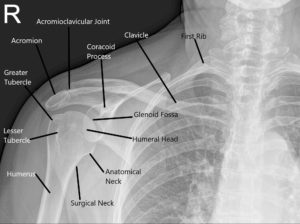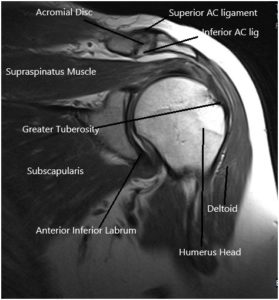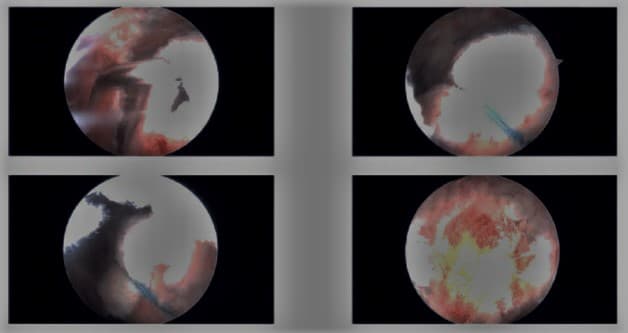Arthroscopy – Shoulder Joint
Shoulder arthroscopy is a minimally invasive technique to treat various shoulder problems. The technique may be utilized to visualize, diagnose, and treat shoulder conditions. Arthroscopic procedures have evolved rapidly over the years. They are being used to treat a wide variety of shoulder conditions, not just limited to sports injuries.
A tiny instrument about the size of a pencil is inserted in the shoulder joint. The instrument has magnifying lenses and a camera. The video feed is displayed on a large monitor. The operating surgeon utilizes the live video feed to guide minuscule instruments to treat various conditions.
X-ray showing the normal shoulder anatomy.
The shoulder joint is a large ball and socket joint. The upper end of the arm bone (humerus) forms the ball. The socket is formed by the outer side of the shoulder blade (scapula).
The outer end of the collar bone (clavicle) also forms a joint with the shoulder blade (acromioclavicular joint). Various tendons and ligaments stabilize the shoulder joint and aid in its movement.
Benefits
Arthroscopic surgery is a minimally invasive surgery. The incisions typically being the size of a buttonhole. On the contrary, the open procedures utilize a large incision. A smaller incision promises early healing and a smaller scar.
The patients are typically able to go home the same day of the procedure. The procedure is usually performed under general or regional anesthesia. There is usually overnight or extended stay for open procedures.
The arthroscopic procedure is associated with lesser pain and swelling compared with open procedures. The incisions being keyhole, the patients experience far less pain. There is also a decreased need for pain medications.
Improved function and early recovery than open surgical procedures. The tissue insult is far less in arthroscopic than open procedures. The patients typically recover early and regain function faster than open procedures.
There are fewer complications with arthroscopic surgery compared with open surgery. The small incision allows decreased chances of infection and bleeding.
MRI of the shoulder joint.
Conditions treated
Sports injuries, injuries associated with falls, and chronic conditions can be treated with shoulder arthroscopy.
- Recurrent shoulder dislocations may require surgical intervention. Arthroscopic surgery offers early rehabilitation and gain of function.
- The rotator cuff is a tough sheath formed by the tendons surrounding the joint. The rotator cuff is responsible for keeping the shoulder joint in place. Rotator cuff repair can be successfully undertaken with an arthroscope.
- Ligaments of the shoulder joint can also be repaired with arthroscopic surgery. The ligaments maintain shoulder stability in various ranges of motion.
- Debridement of the adhesions may be necessary for a frozen shoulder. Additionally, any loose cartilage and bone spurs can also be removed with an arthroscope.
- The labrum is a tough tissue present around the socket. Tears of the labrum can lead to shoulder imbalance and require surgical management.
Procedure
The patients are positioned for the surgery on a beach chair or on the side (lateral decubitus) in the operating room. Depending upon the surgery, general anesthesia or regional anesthesia is given to the patient. In the case of regional anesthesia, only the shoulder region and surrounding parts are made numb. The patient is additionally given sedatives to help the patient sleep during the procedure.
The joint is inflated with saline for better visualization of the structures. The arthroscope with camera and light is entered in the joint through one of the incisions. The camera outputs to display on a video monitor.
Intraoperative arthroscopic images.
Saline flows continuously to provide a clear view and control bleeding. Other keyhole incisions are needed for instrumentation.
The injured parts are visualized and treatment is done depending upon the requirement. Various instruments are used to cut, shave, debride, and suture the torn parts. Specialized sutures known as anchor sutures may be used to attach tissues to the bone. These are made of plastic or metal and are not removed after the surgery.
Once the repair is complete, the keyhole incisions are closed and small steri-strips or bandages may be applied. Usually, the arm is supported in a sling after arthroscopic shoulder surgery. Anti-inflammatory and other pain medications may be used to relieve pain after the surgery.
Complications
Although very rare, arthroscopic surgery can have complications such as infection, blood loss, implant failure, broken arthroscope, etc. There can be intraoperative damage to the nerves and vessels surrounding the joint. The complications in the arthroscopic procedures are far less than the open procedure.
Recovery
The patients have a varying recovery time depending upon the surgery. Generally, the patient makes a full recovery in 6 weeks. A rehabilitation program consisting of physical therapy is started based on the surgery done to achieve maximum function postop. The patients return to work and activities they love faster than open procedures.
My name is Dr. Suhirad Khokhar, and am an orthopaedic surgeon. I completed my MBBS (Bachelor of Medicine & Bachelor of Surgery) at Govt. Medical College, Patiala, India.
I specialize in musculoskeletal disorders and their management, and have personally approved of and written this content.
My profile page has all of my educational information, work experience, and all the pages on this site that I've contributed to.




